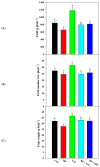Application of Trichoderma harzianum, 6-pentyl-α-pyrone and Plant Biopolymer Formulations Modulate Plant Metabolism and Fruit Quality of Plum Tomatoes
- PMID: 32575500
- PMCID: PMC7356659
- DOI: 10.3390/plants9060771
Application of Trichoderma harzianum, 6-pentyl-α-pyrone and Plant Biopolymer Formulations Modulate Plant Metabolism and Fruit Quality of Plum Tomatoes
Abstract
Many Trichoderma are successfully used to improve agriculture productivity due to their capacity for biocontrol and to stimulate plant growth and tolerance to abiotic stress. This research elucidates the effect of applications with Trichoderma harzianum strain T22 (T22), or biopolymer (BP) alone or in combination (BP + T22 or BP + 6-pentyl-α-pyrone (6PP); a Trichoderma secondary metabolite) on the crop performance, nutritional and functional quality of greenhouse tomato (Solanum lycopersicum L. cultivar Pixel). T22 elicited significant increases in total yield (+40.1%) compared to untreated tomato. The content of lycopene, an important antioxidant compound in tomatoes, significantly increased upon treatment with T22 (+ 49%), BP + T22 (+ 40%) and BP + 6PP (+ 52%) compared to the control. T22 treatments significantly increased the content of asparagine (+37%), GABA (+87%) and MEA (+102%) over the control; whereas BP alone strongly increased GABA (+105%) and MEA (+85%). The synthesis of these compounds implies that tomato plants are able to reuse the photorespiratory amino acids and ammonium for producing useful metabolites and reduce the pressure of photorespiration on plant metabolism, thus optimizing photosynthesis and growth. Finally, these metabolites exert many beneficial effects for human health, thus enhancing the premium quality of plum tomatoes.
Keywords: GABA; Pluronic F-127; Solanum lycopersicum L.; amino acids; carboxymethyl cellulose; lycopene; microbial biostimulant; non-microbial biostimulant.
Conflict of interest statement
The authors declare no conflict of interest.
Figures


References
-
- Shennan C., Krupnik T., Baird G., Cohen H., Forbush K., Lovell R., Olimpi E. Organic and Conventional Agriculture: A Useful Framing? Annu. Rev. Environ. Resour. 2017;42 doi: 10.1146/annurev-environ-110615-085750. - DOI
-
- FAO . Transforming the World through Food and Agriculture—FAO and the 2030 Agenda for Sustainable Development. FAO; Rome, Italy: 2019. [(accessed on 4 May 2020)]. p. 36. Available online: http://www.fao.org/documents/card/en/c/CA5299EN/
-
- Du Jardin P. Plant biostimulants: Definition, concept, main categories and regulation. Sci. Hortic. 2015;196:3–14. doi: 10.1016/j.scienta.2015.09.021. - DOI
Grants and funding
LinkOut - more resources
Full Text Sources

